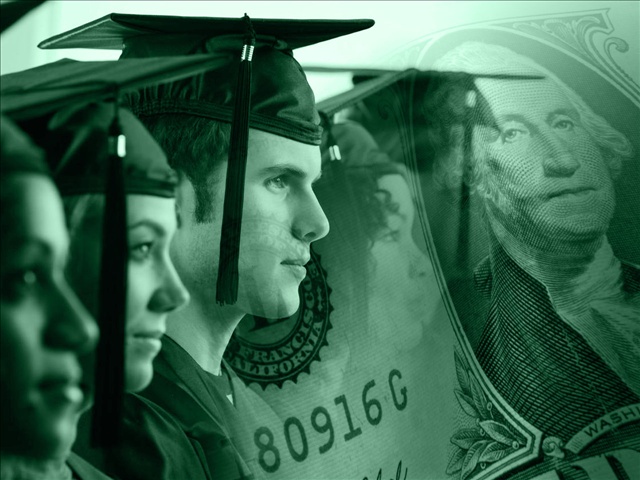
A college degree is more important than it used to be. The world is more competitive as the economy expands globally. College graduates earn $17,500 more annually than high school graduates[ref]Charen, Mona. “How to Make College Affordable.” National Review Online. 16 May 2014. Web. 30 Nov. 2015[/ref]. Employers believe a college degree means that a young adult has learned valuable skills and is willing to work hard. But in recent decades, attending college also means excessive personal debt. America’s cumulative student loan debt is currently $1.2 trillion and eight million young adults have defaulted on their loans[ref]Healy, Patrick. “Hillary Clinton to Offer Plan on Paying College Tuition Without Needing Loans.” The New York Times. The New York Times, 9 Aug. 2015. Web. 30 Nov. 2015[/ref]. This delays marriage,
having children, the purchase of houses and cars, and other decisions that slow economic growth. In 1975, college costs started rising faster than inflation. Since 1982, the cost of a college degree has risen by 1,120 percent[ref]”A Timeline of College Tuition – BestCollegesOnline.com.” BestCollegesOnlinecom. 8 Aug. 2011. Web. 30 Nov. 2015[/ref]. This issue has attracted bipartisan attention, but it is not a problem that the federal government can solve alone without resorting to massive spending. The vendetta is to develop a comprehensive solution to college costs understanding it will require difficult decisions from the government, colleges, and students.
Solutions proposed by Democratic politicians involve lowering the interest rates on federally backed student loans. This ignores the fact that interest rates “aren’t arbitrary figures without purpose — they include the risk that the borrower will not be able to repay the lender. Judging by the severity of the present student-loan crisis and the number of defaults, it’s safe to say interest rates are already too low.”[ref]Hedger, Patrick. “Hillary’s Student-Loan Plan Is a Desperate Gimmick for the Millennial Vote.” National Review Online. 17 Aug. 2015. Web. 30 Nov. 2015[/ref]. By artificially lowering interest rates further, the government is incentivizing students to borrow more, increasing the amount of student debt.
As strange as it may seem, the government needs to make it more difficult to take out student loans. A recent study by the New York Federal Reserve validated the long-held concerns of many economists and policy analysts alike when it found that “on average, for a $1 increase in the subsidized-loan cap, tuitions rose by as much as 65 cents.”[ref]Hedger, Patrick. “Hillary’s Student-Loan Plan Is a Desperate Gimmick for the Millennial Vote.” National Review Online. 17 Aug. 2015. Web. 30 Nov. 2015[/ref] There is too much money available for the taking by colleges and universities because of generous government loans. This is driving up tuition prices. If the government just keeps increasing what it is willing to lend students, where is the incentive for schools to control costs?
Colleges also have a role to play in reducing college costs. Schools are competing with each other to attract the best students, but by investing in massive athletic programs and comfortable facilities, they are pushing up college costs, and leaving their students in debt. NPR columnist Anya Kamenetz argued that a combination of online courses, fewer non-academic perks, cutting administrative bloat, and focusing on graduation, not just enrollment rates, would make college what it should be — a boon for the poor and middle class[ref]Charen, Mona. “How to Make College Affordable.” National Review Online. 16 May 2014. Web. 30 Nov. 2015[/ref]. But if one college does this by itself, that could hurt, not help, in the marketplace. A lone institution with a reduced price would appear to be out of line with current market conditions, possibly making it appear there was something wrong with the school. Colleges have attempted this in the past and it hasn’t worked[ref]DiSalvo, Steven. “How to Fix the College Debt Crisis – The Boston Globe.” BostonGlobe.com. 17 Aug. 2015. Web. 30 Nov. 2015[/ref]. The federal government needs to impose a price ceiling on college tuition. Governors of Texas, Wisconsin and Florida have called for this. Student loans would be smaller and easier to pay back. According to the College Board, the average cost of tuition and fees for the 2015–2016 school year was $32,405 at private colleges, $9,410 for state residents at public colleges, and $23,893 for out-of-state residents attending public universities.
States need to expand investment into higher education. State spending on colleges has decreased since the mid-1970s, especially after the 2008 recession. State funding has yet to return to pre-recession levels. Since 2011, colleges have taken in more as tuition than from state funding. Instead of tax cuts, state investments into higher education could lower the cost of tuition to students and save colleges from extreme cost cutting.
Young adults need to make decisions that make financial sense. Some should consider trade schools or community college, instead of university, to avoid incurring large student loan debt while still receiving post-high school education. Young adults should also consider the long-term career prospects before declaring their major, in order to receive the maximum economic gain for having attended college.
America’s national debt is too large for the government to simply forgive student borrowers. It could establish a framework where graduates who obtain better paying jobs pay back their loans at a faster rate than graduates who obtain lower paying jobs or have difficulty finding employment.
A program could be developed that allows the government to cover the cost of tuition in exchange for two years of public service. The students would serve in the military, mentor lower-class youth, help take care of the elderly in nursing homes, or other public services. This program could give young people real world experience and demonstrate the importance of being good citizens in their communities, which is the most important lesson any education should provide.



